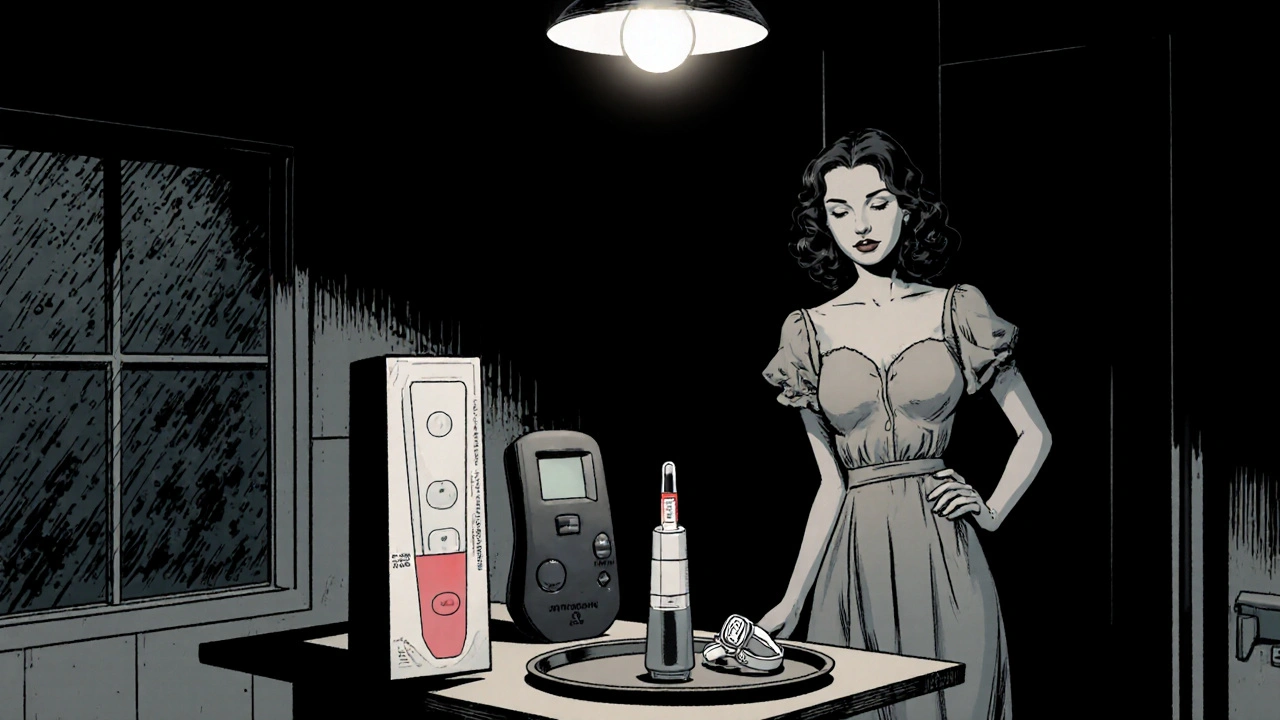Ovulation Test Selector
Find Your Perfect Ovulation Test
Answer a few questions to get personalized recommendations based on your cycle, budget, and preferences
Your Personalized Recommendation
Why this test? Based on your answers:
Key Details
Accuracy:
Cost per cycle:
Best for:
Start testing on:
Quick Takeaways
- Know the three main detection methods: urine strips, digital meters, and saliva or wearable sensors.
- Match the test type to your cycle regularity, budget, and lifestyle.
- Check accuracy rates (85‑99%) and read‑time before buying.
- Follow proper timing - start testing 4‑5 days before the expected surge.
- Avoid common pitfalls like testing too early or using diluted urine.
When you’re trying to pinpoint your fertile window, the ovulation test is a diagnostic tool that detects the luteinizing hormone (LH) surge in urine or other bodily fluids, signaling that ovulation is likely within 24‑36 hours. Picking the right one can feel overwhelming - there are strips, digital meters, saliva kits, and even wearable trackers. This guide breaks down the science, the options, and the decision‑making checklist so you can choose a test that fits your body and budget.
Understanding How Ovulation Tests Work
All ovulation tests rely on the same hormonal cue: the LH surge is a rapid increase in luteinizing hormone that triggers the release of an egg from the ovary. In a typical 28‑day cycle, the surge occurs about 24‑36 hours before ovulation. By detecting this spike, a test tells you the “golden window” for conception.
There are two biological samples most commonly used:
- Urine - the traditional medium for strip and digital tests.
- Saliva - some kits look for changes in estrogen that appear a few days before the LH surge.
Wearable devices, on the other hand, monitor skin temperature, heart rate variability, and hormone levels through sweat, providing a continuous readout without the need for daily testing.
Types of Ovulation Tests
Here’s a quick rundown of the main categories, each with its own strengths and trade‑offs.
- Strip ovulation test uses a simple paper strip that changes color when LH is detected. It’s cheap, easy to use, and works well for regular cycles.
- Digital ovulation test features a handheld meter that reads the strip and displays a clear “positive”, “negative”, or “high” result. Ideal for users who prefer a numeric readout and want reduced ambiguity.
- Saliva ovulation test detects changes in estrogen levels by examining the crystallization pattern of dried saliva. It can give a slightly earlier indication than urine tests.
- Wearable fertility tracker is a wrist‑or ring‑device that continuously measures basal body temperature, heart rate variability, and hormone metabolites in sweat. Best for tech‑savvy users who want day‑long data.
- Dual‑hormone test measures both LH and estrogen in urine, offering a broader picture of the fertile window. Useful for women with irregular cycles or conditions like PCOS.

Key Criteria for Choosing the Right Test
Use this checklist to narrow down options based on your personal situation.
- Cycle regularity - If you have a predictable 28‑day cycle, a basic strip test is sufficient. Irregular cycles may benefit from digital or dual‑hormone kits.
- Budget - Strips cost as little as $0.50 each, while digital meters range $20‑$40 plus supplies. Wearables can exceed $200 upfront but eliminate ongoing strip purchases.
- Ease of reading - Color‑change strips can be ambiguous; digital displays remove guesswork.
- Timing flexibility - Saliva kits let you test earlier in the cycle; wearable devices provide continuous monitoring.
- Medical conditions - Women with PCOS often experience multiple LH surges, making single‑surge tests less reliable may need dual‑hormone or wearable solutions.
Comparison Table: Which Test Fits Your Needs?
| Test Type | Detection Method | Result Format | Typical Accuracy | Price per Cycle | Best For |
|---|---|---|---|---|---|
| Strip | Urine LH | Color change | 85‑90% | $5‑$10 | Regular cycles, tight budget |
| Digital | Urine LH (meter) | Digital readout | 92‑95% | $15‑$25 (meter) + $6‑$12 strips | Those who want clear results |
| Saliva | Estrogen crystallization | Microscope pattern | 80‑85% | $12‑$18 | Early detection, no urine needed |
| Wearable | Skin temp, HRV, sweat hormones | App‑based chart | 90‑96% | $200‑$250 (device) + free app | Tech lovers, continuous data |
| Dual‑hormone | Urine LH + estrogen | Color + digital indicator | 94‑98% | $30‑$45 | Irregular cycles, PCOS |
How to Use an Ovulation Test Correctly
Even the most accurate test won’t help if you use it wrong. Follow these steps to get reliable results.
- Mark Day 1 of your menstrual period (first day of full flow).
- Calculate your estimated fertile window: (Cycle length - 14) ± 2 days. For a 28‑day cycle, start testing around day 10.
- Test at the same time each day, preferably in the afternoon when LH peaks in urine.
- Use the first‑morning urine only if the kit specifically recommends it.
- Read results within the time frame listed in the instructions (usually 5‑10 minutes for strips, 1‑2 minutes for digital meters).
- Record each result in a log or app to spot patterns.
Remember, a “positive” result means the surge has begun, not that ovulation has already happened. Have intercourse or use a friendly sperm‑friendly device within the next 24‑36 hours for the best chance of conception.
Common Mistakes and How to Avoid Them
- Testing too early. Starting before day 7 in a 28‑day cycle may give false negatives.
- Drinking too much fluid. Over‑hydration dilutes LH, making the line faint.
- Reading after the recommended window. Colors can fade, leading to misinterpretation.
- Using the same test brand for a different hormone. Dual‑hormone kits require two separate strips; mixing them invalidates results.
- Ignoring medical conditions. PCOS or thyroid issues can cause baseline LH elevation; consult a clinician for a tailored testing plan.
When to Seek Professional Help
If you’ve been testing for three cycles without a clear surge, or if your cycles are consistently shorter than 21 days or longer than 35 days, it’s time to talk to a reproductive specialist. A blood test measuring estradiol, progesterone, and LH can provide a more precise picture than home kits.
Frequently Asked Questions
How accurate are home ovulation tests compared to blood tests?
Home urine tests detect the LH surge with an accuracy of 85‑95% depending on the brand. Blood tests measuring LH and estradiol are slightly more precise (≈98%) but require a clinic visit and cost more.
Can I use the same test if I have irregular periods?
Irregular cycles make it hard to predict the testing window. Dual‑hormone kits or wearable trackers are better choices because they give a broader fertility signal beyond just the LH surge.
Do I need to stop using lubricants during the fertile window?
Most water‑based lubricants are sperm‑friendly, but oil‑based products can hinder motility. If you’re trying to conceive, opt for a fertility‑approved lubricant or go lubricant‑free.
Is a positive result the same as ovulation?
No. A positive result signals the LH surge, which precedes ovulation by about 24‑36 hours. That’s the window when an egg will be released, not the moment of release itself.
How many days in a row should I test?
Most experts recommend testing daily for 4‑5 days starting from the earliest estimated fertile day. If you get a positive, keep testing for one more day to confirm the surge isn’t a false‑positive.
Choosing the right ovulation test is a blend of science, budget, and personal comfort. By understanding how each technology works and matching it to your cycle profile, you’ll boost your chances of catching that fertile window without the guesswork.






12 Comments
Laneeka Mcrae
October 15, 2025First off, you need to know what your cycle looks like before you buy anything. If you have a regular 28‑day pattern, a cheap strip will do the job just fine. For irregular cycles, the digital or dual‑hormone kits give you a clearer signal. Don't forget to check the read‑time window on the package-some strips fade after ten minutes. Also, keep your urine concentrated; drinking too much right before testing will dilute the LH line. Bottom line: match the tool to your rhythm and your wallet.
Kendra Barnett
October 15, 2025Totally agree with the guide-starting testing a few days before the expected surge really boosts your chances. I like to set a daily reminder so I don’t miss a day, and I keep a little notebook by my bedside to jot down each result. It’s surprisingly empowering to see the pattern emerge over a couple of cycles. If you’re on a tight budget, the basic strips are still reliable as long as you follow the timing rules. Remember, consistency is key, and don’t be hard on yourself if the first round feels confusing.
Warren Nelson
October 15, 2025Nice rundown. I’ve tried both the strip and the digital meter, and the meter saved me from the “is that line faint enough?” debate. The wearable looked cool but the subscription fees scared me off. One thing I’d add: make sure you’re using the first‑morning urine only if the kit says so-otherwise afternoon samples are fine. Also, a quick tip-store your test strips in a cool, dry place; heat can mess with the chemicals. Overall, the guide hits the main points without overcomplicating things.
Jennifer Romand
October 15, 2025While the pragmatic approach is admirable, one cannot ignore the subtle art of fertility monitoring. The hormonal orchestra within each body performs a nuanced symphony, and reducing it to cheap strip paper feels almost sacrilegious. A dual‑hormone assay, with its elegant dual‑peak detection, offers a drama worthy of the stage. Moreover, the aesthetic of a digital display provides a visual crescendo that fills the soul. In short, elevate your practice beyond the mundane.
Kelly kordeiro
October 15, 2025In addressing the paramount considerations delineated within the aforementioned guide, one must first acknowledge the intricate interplay between physiological variability and technological precision.
The selection of an ovulation assay, be it the modest paper strip or the sophisticated wearable, ought not be predicated solely upon fiscal constraints, but rather upon a comprehensive appraisal of individual endocrinological idiosyncrasies.
Indeed, the luteinizing hormone surge, while ostensibly a discrete event, may manifest with atypical amplitude in conditions such as polycystic ovary syndrome, thereby necessitating a dual‑hormone paradigm.
Consequently, the utilization of a dual‑hormone kit affords the practitioner a bifurcated lens through which both luteinizing hormone and estradiol fluctuations may be observed concomitantly.
Such granularity, albeit accompanied by a modest elevation in monetary outlay, confers a substantial increment in predictive fidelity.
Furthermore, the temporal fidelity of testing-commencing no later than the tenth day of a prototypical twenty‑eight day cycle-remains a sine qua non for optimal data acquisition.
One must also rigorously adhere to the protocol of testing at a consistent diurnal interval, thereby mitigating the confounding influence of circadian hormonal oscillations.
The guide aptly cautions against hyper‑hydration, a practice that, through dilution of urinary constituents, engenders a diminution of line intensity and potential false‑negative outcomes.
Equally, the ludicrous practice of reading results beyond the manufacturer‑specified window is an affront to scientific rigor.
In the realm of digital meters, the unequivocal numeric readout obviates the ambiguity inherent to chromatic interpretation, yet it is incumbent upon the user to verify the device’s calibration periodically.
Wearable technologies, while undeniably avant‑garde, must be scrutinized for algorithmic transparency, as proprietary analytics may obscure the underlying physiological signals.
A judicious practitioner will therefore balance the allure of continuous monitoring against the imperative for validated, evidence‑based outputs.
It is also prudent to integrate the ovulation data with basal body temperature measurements, thereby constructing a multidimensional fertility profile.
Such an integrative approach not only augments accuracy but also empowers the individual with a holistic understanding of her reproductive timeline.
In summation, the decision matrix articulated herein should be navigated with both empirical discernment and an appreciation for the subtle artistry of human fertility.
Chris Fulmer
October 15, 2025I appreciate how the article balances scientific detail with practical tips. Many newcomers are curious about whether the timing of the LH surge can shift significantly from cycle to cycle; the answer is yes-especially under stress or hormonal fluctuations. That’s why keeping a log, whether paper or app‑based, can reveal those subtle shifts. If you notice erratic patterns, consulting a clinician for a serum hormone panel is a wise next step. Overall, the guide offers a solid foundation for anyone embarking on this journey.
William Pitt
October 15, 2025Exactly, tracking trends over a few cycles gives you the data you need to predict the surge more confidently. I always pair the urine test with a simple temperature chart; the slight dip before the rise is a reliable backup. If your budget allows, upgrading to a digital strip eliminates the guesswork of line intensity. Keep the routine consistent and you’ll see the pattern emerge without the anxiety of missed days.
Jeff Hershberger
October 15, 2025The guide nails the basics.
Jesse Najarro
October 15, 2025I think we should also note that some insurance plans actually cover certain kits so checking with your provider could save you money and that’s worth looking into
Suraj Midya
October 15, 2025India has its own affordable kits that work just fine, you dont need to import pricey ones. Just read the label and follow the timing.
ashish ghone
October 15, 2025Hey friends, I just wanted to share my two‑cents on why I gravitate toward the wearable trackers 🤖. They give you a real‑time map of temperature, heart‑rate variability, and even subtle hormone changes through sweat, which means you’re not tied to a single urine sample each day. I know some folks think it’s overkill, but once you see the app’s fertility curve, the peace of mind is unmatched. Plus, the data exports to spreadsheets, so you can do a deep dive if you’re the analytical type. The downside? The upfront cost can be a hurdle, but many brands run seasonal discounts that bring the price down into a more manageable range. If you’re on a shoestring budget, pairing a basic strip with a diligent log can still yield solid results. In any case, the key is consistency-whether you choose a strip, a digital meter, or a high‑tech wearable, stick to the same testing window each day, and you’ll maximize accuracy. 🌸
steph carr
October 15, 2025Great summary! I love how this guide makes the science feel accessible. Remember to stay positive and celebrate each small win, whether it’s a clear positive line or simply the habit of daily tracking. Your body will thank you for the attention.